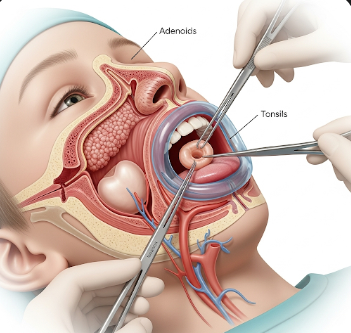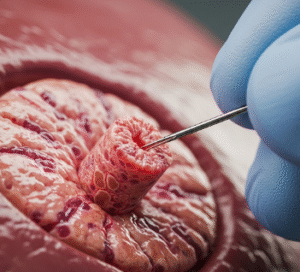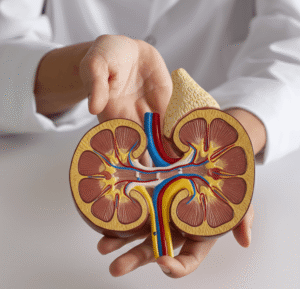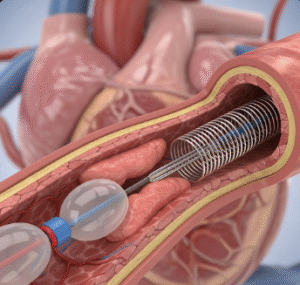Overview
Adeno-tonsillectomy is a surgical procedure performed to remove the adenoids and tonsils in children. These lymphoid tissues are part of the immune system but can cause chronic infections, sleep disturbances, or breathing problems when enlarged or infected.
In Korea, adeno-tonsillectomy is performed in advanced pediatric ENT centers by experienced otolaryngologists, using state-of-the-art surgical techniques. The procedure is generally safe, minimally invasive, and effective, with children often returning home within a day or two.
What is Adeno-Tonsillectomy?
Adeno-tonsillectomy involves surgically removing the tonsils from the throat and the adenoids from the upper airway.
Indications include:
- Recurrent tonsillitis or adenoid infections
- Sleep-disordered breathing or obstructive sleep apnea
- Difficulty swallowing or breathing due to enlarged tissues
- Chronic ear infections or sinusitis
Key points:
- Improves airway function, sleep quality, and overall health
- Reduces frequency of infections and related complications
- Commonly performed in children aged 3–12 years, though sometimes in younger or older children
What are the benefits?
- ✅ Relieves recurrent infections (tonsillitis or adenoiditis)
- ✅ Improves sleep quality and reduces snoring
- ✅ Enhances breathing and swallowing
- ✅ Prevents complications such as ear infections, sinusitis, or growth issues
- ✅ Quick recovery and minimal scarring with modern surgical techniques
- ✅ In Korea, pediatric ENT surgeons provide comprehensive pre- and post-operative care
Procedure Details
1) How should I prepare for Adeno-Tonsillectomy?
- ➤ Preoperative evaluation: ENT assessment, blood tests, and sometimes imaging
- ➤ Discuss current medications, allergies, and any past medical history
- ➤ Fasting instructions prior to surgery
- ➤ Counseling about procedure, anesthesia, post-op care, and potential risks
- ➤ Arrange for parental support and post-surgery monitoring at home
2) What happens during the procedure Adeno-Tonsillectomy?
- ✅ Performed under general anesthesia
- ✅ Tonsils and adenoids are surgically removed using cold knife, cautery, or laser techniques
- ✅ Bleeding is controlled during surgery to ensure safety
- ✅ Procedure typically lasts 30–60 minutes depending on the child and technique
- ✅ Patient is monitored closely during surgery and in recovery
3) What happens after Adeno-Tonsillectomy?
- ➤ Child monitored in recovery until fully awake
- ➤ Pain management using child-friendly analgesics
- ➤ Encourage hydration and soft diet
- ➤ Gradual return to normal activity over 1–2 weeks
- ➤ Parents instructed to watch for bleeding, infection, or dehydration
- ➤ Follow-up visit to ensure proper healing and recovery
Risks / Benefits
Potential Risks:
- ➤ Postoperative bleeding (most common in first 24 hours or 5–10 days later)
- ➤ Infection at surgical site
- ➤ Pain or difficulty swallowing
- ➤ Rare: anesthesia complications, dehydration, or voice changes
Benefits:
- ✅ Resolves chronic infections and sleep-disordered breathing
- ✅ Improves overall health, growth, and development
- ✅ Minimally invasive and well-tolerated in children
- ✅ In Korea, advanced pediatric ENT care reduces risks and ensures safe recovery
Recovery and Outlook
- Hospital stay: Usually same day or 1 overnight for observation
- Diet: Start with soft, cool foods; avoid hard or spicy foods
- Activity: Gradual return to normal activity; avoid strenuous play for 1–2 weeks
- Pain management: Medications as prescribed; ice packs or cold liquids for comfort
- Full recovery: Typically 7–14 days, with improvement in breathing, sleep, and infections
- Follow-up: ENT review to check for healing and any complications
When To Call the Doctor
- ➤ Persistent or severe bleeding from mouth or nose
- ➤ Fever, signs of infection, or worsening pain
- ➤ Dehydration due to inability to drink fluids
- ➤ Breathing difficulties or noisy, labored breathing
- ➤ Any unusual symptoms during recovery
Best Korea Option / Process
- ✅ Korea provides high-quality pediatric ENT hospitals
- ✅ Procedures performed by experienced ENT surgeons with specialized pediatric care
- ✅ Advanced techniques minimize bleeding, pain, and complications
- ✅ Postoperative care includes pain control, hydration monitoring, and dietary guidance
- ✅ International families benefit from VIP services, English-speaking staff, and coordinated pediatric care
- ✅ High safety standards make Korea a preferred destination for adeno-tonsillectomy in children













